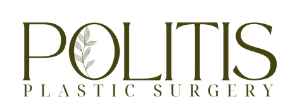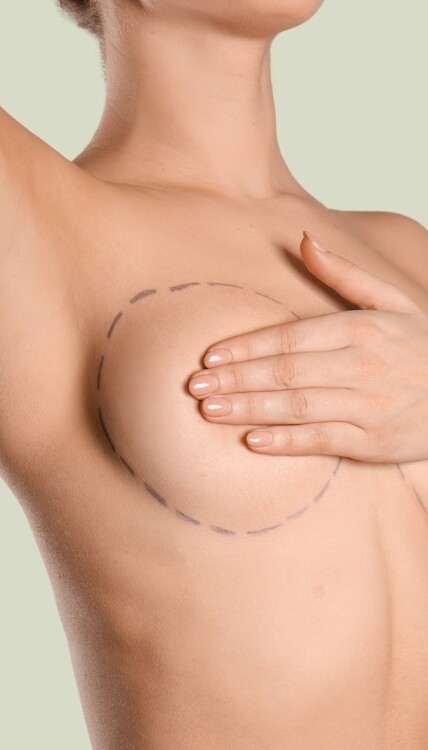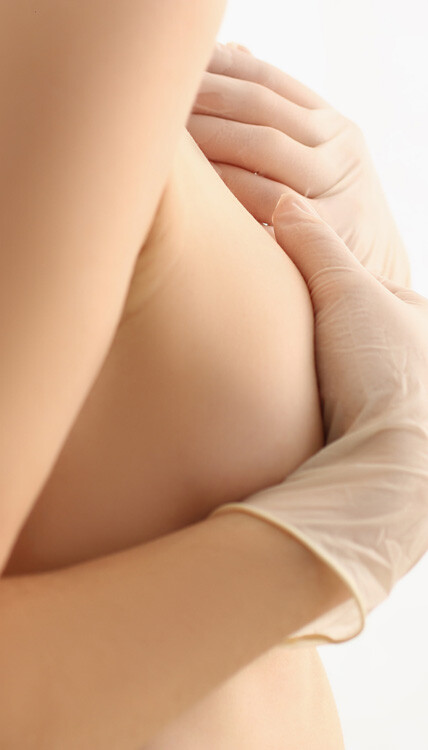Key Takeaways:
- Breast augmentation incisions come with different advantages and disadvantages, and must be carefully considered.
- Plastic surgeons must understand what the patient’s desired results are in order to make an appropriate recommendation for the best incision.
- Board-certified plastic surgeons from Politis Plastic Surgery can assist patients in selecting the best incision and ensuring they receive safe, effective, and natural-looking results.
 Breast augmentation is a type of plastic surgery performed to enhance the size and shape of one’s breasts. Generally, the procedure is utilized to improve self-image and self-confidence. During the procedure, a plastic surgeon will insert breast implants and choose where to make the incision. Breast augmentation incisions are typically made beneath the breast, around the areola, in the armpit, or through the navel. Although, different incisions may present different sets of advantages and disadvantages, they all may cause the same amount of pain and discomfort. Knowing the differences between each incision is important when determining the best option for surgical results.
Breast augmentation is a type of plastic surgery performed to enhance the size and shape of one’s breasts. Generally, the procedure is utilized to improve self-image and self-confidence. During the procedure, a plastic surgeon will insert breast implants and choose where to make the incision. Breast augmentation incisions are typically made beneath the breast, around the areola, in the armpit, or through the navel. Although, different incisions may present different sets of advantages and disadvantages, they all may cause the same amount of pain and discomfort. Knowing the differences between each incision is important when determining the best option for surgical results.
Types of Incisions
Inframammary incision: An inframammary incision is made beneath the breast, usually along the crease of the inframammary fold. This type of incision is most commonly used for many different surgical procedures, as it gives the plastic surgeon great access. Additionally, scarring can be minimized and the incision can be placed in a camouflaged location.
Advantages: Can be easily hidden beneath the breast crease, can access the implant pocket with ease, and the effectiveness of the incision is quite high
Disadvantages: The risk of infection is increased due to how close the incision is to the breast tissue, and some patients may experience numbness in the breast for up to a year.
Periareolar incision: A periareolar incision is made around the nipple and is considered one of the most subtle breast augmentation incisions. This type of incision is common among patients that want a natural-looking result.
Advantages: One of the most minimally invasive incisions, scarring can be blended with the surrounding skin, and hides the implant well
Disadvantages: Positioning of the implant is limited, can cause disruption of the milk ducts, and leads to a greater risk of infection during the healing process.
Transaxillary incision: A transaxillary incision is made in the armpit, placing the implant behind the muscle via the armpit. This incision is good for avoiding visible scarring.
Advantages: It leaves virtually no scarring, as the incision will be concealed in the armpit, allows for very precise control of the implant placement, and is minimally invasive
Disadvantages: The chances for infection remain fairly high, there is an increased risk of capsular contracture, and the distance from the incision to the implant means it requires more skill from the surgeon.
Transumbilical (TUBA) incision: A transumbilical incision is made through the navel, using an endoscope to help with positioning of the implant.
Advantages: No scarring, because the incision is made through the navel, no cutting into the breast, and is minimally invasive
Disadvantages: Limited access, can be difficult to treat in case of implant deflation or rupture, and increased risk of infection due to the length of the incision.
Summary
Each of these incisions offer different advantages and disadvantages, so it is important to speak with a board-certified plastic surgeon to decide which one is best for you. During the consultation, a patient should outline the desired results, which will enable the plastic surgeon to make a recommendation for the best incision for their particular needs.
In conclusion, breast augmentation incisions come with different advantages and disadvantages, and it is necessary to inform yourself about their characteristics. This can be done through consultation with a board-certified plastic surgeon, who should provide guidance when selecting the incision type.
At Politis Plastic Surgery, our skilled and experienced plastic surgeons understand the importance of selecting the right incision for your breast augmentation. Our team of experts is committed to providing our patients with the safest, most effective treatments and procedures, resulting in natural-looking and beautiful results. To get started on your journey towards a rejuvenated, confident you, contact us today.
References:
- “Transumbilical Incision: Pros and Cons.” 28 Feb. 2023, https://www.pacificheightsplasticsurgery.com/transumbilical-incision-pros-and-cons/.
- “Breast Implant Incision Placement | Raleigh Plastic Surgeon.” https://www.northraleighplasticsurgery.com/breast-augmentation-incision-placement/.
- “Periareolar Incision Pros & Cons – Pacific Heights Plastic Surgery.” https://www.pacificheightsplasticsurgery.com/periareolar-incision-pros-and-cons/.
- “The Pros and Cons of the Transaxillary Breast Augmentation Incision.” https://www.drkimberlyhenry.com/blog/the-pros-and-cons-of-the-transaxillary-breast-augmentation-incision/.




 Breast augmentation is one of the most commonly performed
Breast augmentation is one of the most commonly performed 

 It is estimated that hundreds of thousands of women in the U.S. choose to have
It is estimated that hundreds of thousands of women in the U.S. choose to have 
 Breast augmentation
Breast augmentation
 The decision to undergo breast augmentation is a very important one. Breast augmentation is a plastic surgery procedure used to increase the size and improve the shape of a woman’s breasts. This can be done through the placement of saline or silicone implants, or through autologous fat transfer. In some cases, a breast lift can also be performed, in order to further improve the appearance of the breasts. Before deciding on a surgical option, the potential benefits and risks of the procedure should be discussed with a qualified plastic surgeon.
The decision to undergo breast augmentation is a very important one. Breast augmentation is a plastic surgery procedure used to increase the size and improve the shape of a woman’s breasts. This can be done through the placement of saline or silicone implants, or through autologous fat transfer. In some cases, a breast lift can also be performed, in order to further improve the appearance of the breasts. Before deciding on a surgical option, the potential benefits and risks of the procedure should be discussed with a qualified plastic surgeon.
 The decision to undergo a breast augmentation surgery is one that should be well researched and thoroughly discussed with a board-certified plastic surgeon.
The decision to undergo a breast augmentation surgery is one that should be well researched and thoroughly discussed with a board-certified plastic surgeon. 
 As a woman, your breasts are an integral part of your overall appearance. And whether they are small or large, perky or not, their appearance can cause a feeling that impacts all areas of your life.
As a woman, your breasts are an integral part of your overall appearance. And whether they are small or large, perky or not, their appearance can cause a feeling that impacts all areas of your life. 
